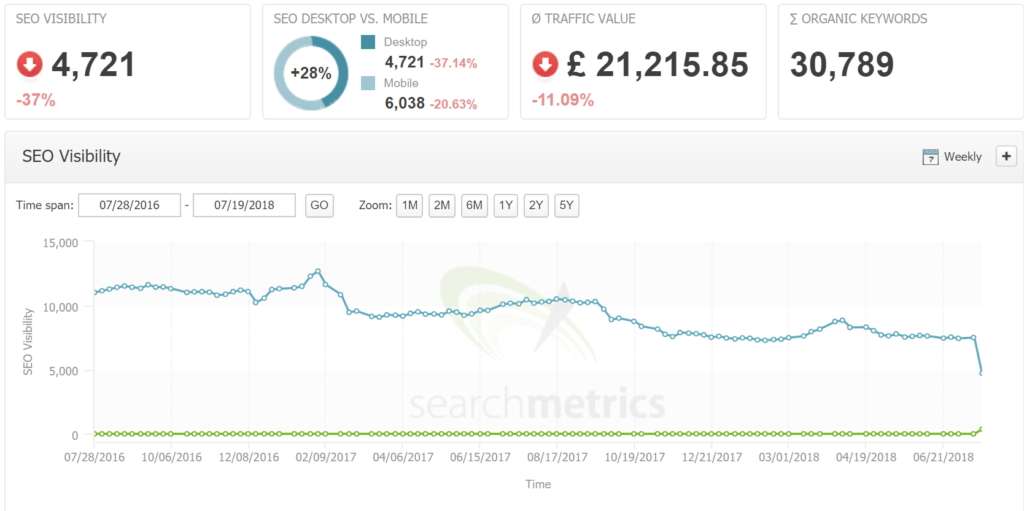How we make sure a domain migration is successful for SEO
1. Objectives and benchmarking: track the metrics that matter from the start

It’s vital that from the very beginning of a migration project that objectives and KPI’s are established and well documented.
Why is a migration happening and what is the scope? A domain (hostname) name change, a ccTLD to capture international markets, a brand new website launch? IP location? Technology? A HTTPS migration? All of those things?
Obviously maintaining the status quo (thus saving your client’s neck and your own) is the underlying point of the project, but in my view there are always opportunities to make gains. In a project like this, we identify opportunities by establishing facts about the project (scope), consulting on objectives (what is possible within the scope of this change), and benchmarking performance (taking a baseline measure of the site prior to the change) and setting expectations on a successful outcome (KPI’s).
2. Perform technical site audits on old and new sites
A site migration is *the* opportunity to mop up all of those difficult legacy site issues that have been kicking around in the task list for years. But what a lot of companies neglect to do is audit the original site as well as auditing the new.
But why audit the old site?
If you review a platform from its log file data, you can see how Google is interacting with the technology as a whole.
Are there rogue JavaScript files receiving unusually high numbers of Googlebot requests per day? Broken image URLs? Legacy errors from previous platforms such as broken index.php files? It’s amazing what you find in the logs, and if those surprises aren’t preempted during the early stages of a migration they will come back to haunt you and your brand new platform down the road. Old websites leave a footprint that is beyond the scope of simple redirect mapping.
There’s a huge amount of data to be collected, all intended to answer one question: “when we move from this site to the new, what will happen?”. If you feel you have a complete answer to this, then you can be confident things will go with few, if any, problems. For our agency, this is the opportunity to really demonstrate expertise.
By the way, it’s good to perform a content audit if you’re going to be changing the existing content significantly.
3. Big brands need big experience
It’s important to note the importance of global brand experience.
The sheer scale of modern platforms is astonishing. Large organisations have multiple languages, mobile considerations, integrations and middleware issues, app indexing issues, almost certainly a prior use of legacy JavaScript libraries and more. Large scale migrations for global brands are serious projects that need scoping, planning and control. A project can involve hundreds of people or more on the client side which poses a unique and incredibly rewarding challenge.
Buyer beware: free ‘Migration Checklists’ on SEO Blogs
It’s easy for SEO writers to list all of the things you’d probably look for in a “migration checklist”, but in the real world experienced SEOs find the problems through their tried and tested audit methodology. Then they write the checklist! Predefined checklists are insulting to our experience, inadvertently restricting, and are frequently irrelevant to an individual project considering all of its uniqueness and idiosyncrasies.
Putting all of the learning from this stage together will yield a scoping document (or roadmap), completely focused on the biggest opportunities and the key risks and potential pain points you might encounter during the process.
4. The migration plan
Using everything you’ve learned, it’s wise to create a domain migration plan.
We create a step-by-step timeline of events with checks and conditions that should be met before progressing to the next stage during the technical execution. Along with the audit recommendations, this is a project plan that is developed, documented and discussed in tandem with the clients.
Close working relationships at this stage are pivotal to success and it’s not unusual to find Builtvisible staff working onsite with their clients and made sure the plan is understood and has commitment from all parties involved.
The key to success – identify the variables
When a domain or site platform changes in some way, what are the variables? What are the flags that might tell a search engine that something significant has changed? This concept has underpinned my thought process for a long time.
Check and double check for the variables. Test your migration plan before execution. Identify what will change, when and how – does your migration plan catch these changes?
If you’re migrating soon
You might have noticed this article doesn’t tell you how to run an effective site migration. It tells you that we do. Here’s some proof – contact us if you’d like more.
There are of course plenty of articles on the Internet that you can read. Many of them are written by the talented consultants at Builtvisible, so here’s some further reading on the subject:
HTTPS Migration – Common Pitfalls, Maria Camanes.
Mapping 301 redirects for SEO-friendly site migrations, Will Nye.
Why re-pointing high value links matters, Luke Berry.
Planning for mixed content during HTTPS migrations, Tom Bennet.


